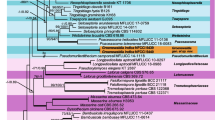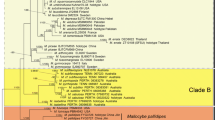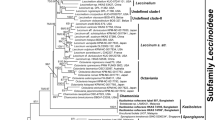Abstract
Microfungi in the Gnomoniaceae (Diaporthales, Ascomycetes) comprise species commonly reported as pathogens and endophytes on trees and herbaceous hosts primarily from temperate forests of North America, Europe, and Japan. The diversity of Gnomoniaceae in China is poorly known, although several plant families that occur there specifically the Betulaceae are considered important hosts. An exploratory trip to Yunnan, China, resulted in the discovery of several members of the Gnomoniaceae. In this paper a new monotypic genus, Occultocarpon and its species, O. ailaoshanense, are described and illustrated. A phylogeny based on three genes (LSU, rpb2, tef1-α) reveals that O. ailaoshanense belongs to the Gnomoniaceae and forms a branch distinct from the currently known genera. Occultocarpon ailaoshanense is characterized by perithecia with thin, central to eccentric necks in groups embedded in a stroma and oblong elliptical-elongated, one-septate ascospores. Occultocarpon ailaoshanense occurs on the bark of branches of Alnus nepalensis (Betulaceae) in Yunnan, China.


Similar content being viewed by others
References
Barr ME (1978) The Diaporthales in North America with emphasis on Gnomonia and its segregates. Mycol Mem 7:1–232
Carbone I, Kohn LM (1999) A method for designing primer sets for speciation studies in filamentous ascomycetes. Mycologia 91:553–556
Castlebury LA, Rossman AY, Jaklitsch WJ, Vasilyeva LN (2002) A preliminary overview of the Diaporthales based on large subunit nuclear ribosomal DNA sequences. Mycologia 94:1017–1031
Chen ZD, Manchester SR, Sun HY (1999) Phylogeny and evolution of the Betulaceae as inferred from DNA sequences, morphology and paleobotany. Am J Bot 86:1168–1181
Eriksson OE, Yue JZ (1988) The Pyrenomycetes of China, an annotated checklist. University of Umea, Sweden, p 88
Fang CFZF, Zhao SD, Skvortsov AK (1999) Salicaceae. In: Wu ZY, Raven PH (eds) Flora of China 4:139–274. Science Press (Beijing) and Missouri Botanical Garden Press (St. Louis)
Felsenstein J (1985) Confidence limits on phylogenies: an approach using the bootstrap. Evolution 39:783–791
Huang CJ, Zhang YT, Bartholomew B (1999) Fagaceae. In: Wu ZY, Raven PH (eds) Flora of China 4:314–400. Science Press (Beijing) and Missouri Botanical Garden Press (St. Louis)
Huelsenbeck JP, Ronquist F (2001) MRBAYES: Bayesian inference of phylogeny. Bioinformatics 17:754–755
Li PQ, Skvortsov AK (1999) Betulaceae. In: Wu ZY, Raven PH (eds) Flora of China 4: 286–313. Science Press (Beijing) and Missouri Botanical Garden Press (St. Louis)
Liu YL, Whelen S, Hall BD (1999) Phylogenetic relationships among ascomycetes: evidence from an RNA polymerase II subunit. Mol Biol Evol 16:1799–1808
Lu AM, Stone DE, Grauke LJ (1999) Juglandaceae. In: Wu ZY, Raven, PH (eds) Flora of China 4:277–285. Science Press (Beijing) and Missouri Botanical Garden Press (St. Louis)
Mejía LC, Castlebury LA, Rossman AY, Sogonov MV, White JF (2008) Phylogenetic placement and taxonomic review of the genus Cryptosporella and its synonyms Ophiovalsa and Winterella (Gnomoniaceae, Diaporthales). Mycol Res 112:23–35
Mejía LC, Rossman AY, Castlebury LA, White JF (2011a) New species, phylogeny, host-associations, and geographic distribution of genus Cryptosporella (Gnomoniaceae, Diaporthales). Mycologia 103:379–399
Mejía LC, Castlebury LA, Rossman AY, Sogonov MV, White JF (2011b) A systematic account of the genus Plagiostoma (Gnomoniaceae, Diaporthales) based on morphology, host-associations, and a four-gene phylogeny. Stud Mycol 68:211–235
Monod M (1983) Monographie taxonomique des Gnomoniaceae. Beihefte zur Sydowia. Ann Mycol Ser 2(9):1–315
Myers N, Mittermeier RA, Mittermeier CG, da Fonseca GAB, Kent J (2000) Biodiversity hotspots for conservation priorities. Nature 403:853–858
Nylander JAA (2004) MrModeltestv2. Program distributed by the author. Evolutionary Biology Centre, Uppsala University
Rehner SA (2001). EF1 alpha primers. Available online at http://ocid.nacse.org/research/deephyphae/EF1primer.pdf
Sogonov MV, Castlebury LA, Rossman AY, Mejía LC, White JF (2008) Leaf inhabiting genera of Gnomoniaceae (Diaporthales). Stud Mycol 62:1–79
Swofford DL (2002) PAUP*. Phylogenetic Analysis Using Parsimony (*and Other Methods). Version 4.0b10. Sinauer Associates, Sunderland
Tai FL (1937). A list of fungi hitherto known from China. Part 2, Ascomycetes. Reprinted from the Science Reports of National Tsing Hua University Ser B, 2:191–239
Tai FL (1979) Sylloge fungorum sinicorum. Science Press, Academia Sinica, Peking (Beijing)
Teng SC (1996) In: Korf RP (ed) Fungi of China. Mycotaxon, LTD, Ithaca, p 586
Walker DM, Castlebury LA, Rossman AY, Sogonov MV, White JF (2010) Systematics of genus Gnomoniopsis (Gnomoniaceae, Diaporthales) based on a three gene phylogeny, host associations and morphology. Mycologia 102:1479–1496
Xu JC, Wilkes A (2004) Biodiversity impact analysis in Northwest Yunnan, Southwest China. Biodiversity Conserv 13:959–983
Acknowledgement
This work was funded by the National Science Foundation Partnerships for Enhancing Expertise in Taxonomy (NSF 03–28364). Additional funding for field work by LCM was received through Rutgers University, New Brunswick, New Jersey, from the Spencer Davis Research Award from the Department of Plant Biology and Pathology, and from the Myron Backus Award from the Mycological Society of America. ZLY was supported by the Hundred Talents Program of the Chinese Academy of Sciences. Christian Feuillet kindly provided translations of the diagnoses into Latin.
Author information
Authors and Affiliations
Corresponding author
Additional information
Mention of trade names or commercial products in this publication is solely for the purpose of providing specific information and does not imply recommendation or endorsement by the U.S. Department of Agriculture. USDA is an equal opportunity provider and employer.
Rights and permissions
About this article
Cite this article
Mejía, L.C., Rossman, A.Y., Castlebury, L.A. et al. Occultocarpon, a new monotypic genus of Gnomoniaceae on Alnus nepalensis from China. Fungal Diversity 52, 99–105 (2012). https://doi.org/10.1007/s13225-011-0108-y
Received:
Accepted:
Published:
Issue Date:
DOI: https://doi.org/10.1007/s13225-011-0108-y




